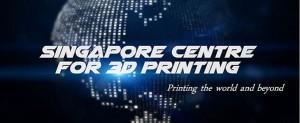 Singapore has been one of the busiest locations in the 3D printing industry lately. The city-state has made 3D printing a major priority, with several large centers and organizations dedicated to the technology. There’s the Global Additive Manufacturing Center of Excellence, and the National Additive Manufacturing Innovation Cluster, which is led by experts from Nanyang Technological University (NTU). Also a part of NTU is the Singapore Centre for 3D Printing, which is working on one of the most daring uses of the technology yet: 3D printed public housing.
Singapore has been one of the busiest locations in the 3D printing industry lately. The city-state has made 3D printing a major priority, with several large centers and organizations dedicated to the technology. There’s the Global Additive Manufacturing Center of Excellence, and the National Additive Manufacturing Innovation Cluster, which is led by experts from Nanyang Technological University (NTU). Also a part of NTU is the Singapore Centre for 3D Printing, which is working on one of the most daring uses of the technology yet: 3D printed public housing.
 Innovations in building construction are slow to take hold, understandably: most people would rather live and work in buildings that have been constructed via traditional, proven methods than ones that have been built using experimental, unproven techniques. In the construction industry, safety should, of course, come before anything else, but that doesn’t mean that new methods shouldn’t be considered and possibly implemented after thorough testing. 3D printing has been discussed for years as the potential future of architecture, and it’s very slowly starting to take hold. We’ve seen temporary 3D printed office spaces, and 3D printed bridges. Many organizations are developing ways of 3D printing major structural elements, and creative ideas for 3D printed walls and interior design elements are flowing like crazy.
Innovations in building construction are slow to take hold, understandably: most people would rather live and work in buildings that have been constructed via traditional, proven methods than ones that have been built using experimental, unproven techniques. In the construction industry, safety should, of course, come before anything else, but that doesn’t mean that new methods shouldn’t be considered and possibly implemented after thorough testing. 3D printing has been discussed for years as the potential future of architecture, and it’s very slowly starting to take hold. We’ve seen temporary 3D printed office spaces, and 3D printed bridges. Many organizations are developing ways of 3D printing major structural elements, and creative ideas for 3D printed walls and interior design elements are flowing like crazy.
The idea of a 3D printed high-rise building is something different, though. While it’s showing itself to be a reliable method of construction in many forms, it’s still so new and relatively untested that it’s a scary prospect for a lot of people – especially when considering living in a printed apartment building thousands of feet off the ground. But that’s precisely the idea that the Singapore Centre for 3D Printing wants to test.
The idea, according to the Centre’s Executive Director Professor Chua Chee Kai, is to print the buildings one story at a time, then transport them to the construction site and stack them like Legos. This “Lego-style” fabrication method, officially known as “Prefabricated Pre-Finished Volumetric Construction,” has already been used to build three new residence halls at NTU, although the individual stackable modules are built with more traditional construction methods.
Not every element of the public housing buildings would be 3D printed, but the major structural components would be. The Centre, which is working with a private company to test the idea, intends to formally present it to government agencies later this year. If all goes according to plan, a prototype could be developed within three years. But first, some extra-large printers will have to be developed – large enough to print major building parts.
“In the area of housing there are quite big challenges,” said Professor Chua. “There is no assistance of 3D printers and no availability of printable concrete. We have to develop all this from scratch.”
 They certainly should have the resources to do so, though. The Singapore Centre for 3D Printing was set up with $150 million by the government and local industry for the purpose of researching ways that 3D printing can be used within the city. Singapore currently depends heavily on foreign workers for construction, which, combined with an aging population, creates some urgency for the government to develop more productive, less labor-intensive construction methods. The Centre is also researching the potential to 3D print weapons parts for the military, as well as multiple healthcare applications. Discuss in the Singapore 3D Printed High Rises forum over at 3DPB.com.
They certainly should have the resources to do so, though. The Singapore Centre for 3D Printing was set up with $150 million by the government and local industry for the purpose of researching ways that 3D printing can be used within the city. Singapore currently depends heavily on foreign workers for construction, which, combined with an aging population, creates some urgency for the government to develop more productive, less labor-intensive construction methods. The Centre is also researching the potential to 3D print weapons parts for the military, as well as multiple healthcare applications. Discuss in the Singapore 3D Printed High Rises forum over at 3DPB.com.
Subscribe to Our Email Newsletter
Stay up-to-date on all the latest news from the 3D printing industry and receive information and offers from third party vendors.
Print Services
Upload your 3D Models and get them printed quickly and efficiently.
You May Also Like
The Dental Additive Manufacturing Market Could Nearly Double by 2033, According to AM Research
According to an AM Research report from 2024, the medical device industry, specifically in dentistry, prosthetics, and audiology, is expected to see significant growth as these segments continue to benefit from...
Heating Up: 3D Systems’ Scott Green Discusses 3D Printing’s Potential in the Data Center Industry
The relentless rise of NVIDIA, the steadily increasing pledges of major private and public investments in national infrastructure projects around the world, and the general cultural obsession with AI have...
AM Research Webinar Explores Continuum’s Sustainable Metal Additive Manufacturing Powders
Metal additive manufacturing (AM) powder supplier Continuum Powders is working to develop solutions that empower industries to reduce waste and optimize their resources. An independent life cycle assessment (LCA) of...
3D Printed Footwear Startup Koobz Lands $7.2M in Seed Round
California-based Koobz is focused on reshoring the U.S. footwear supply chain with advanced manufacturing processes, including 3D printing. The startup just announced that it has added $6 million to its...

































